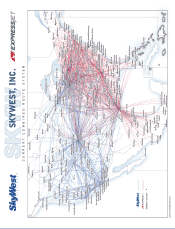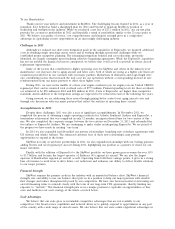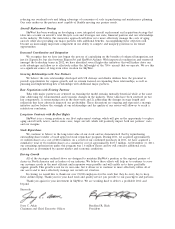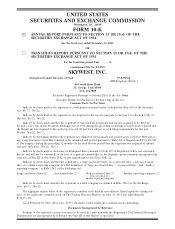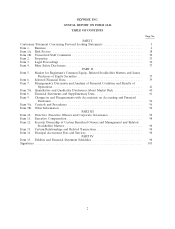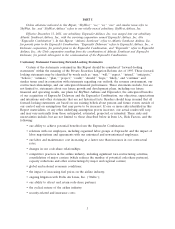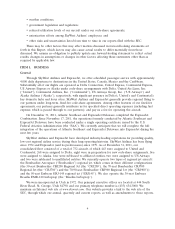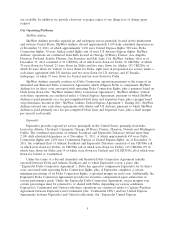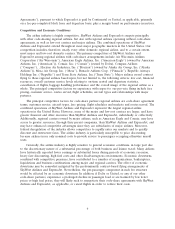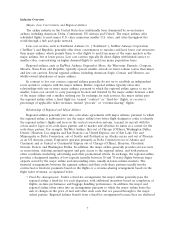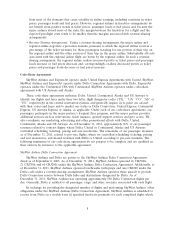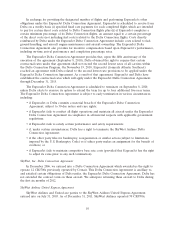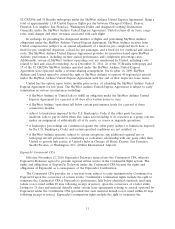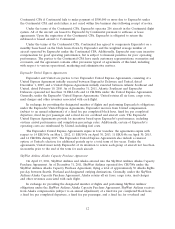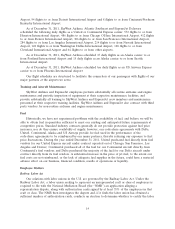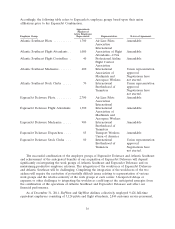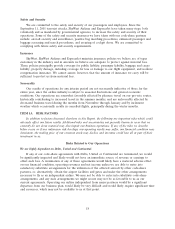SkyWest Airlines 2011 Annual Report Download - page 12
Download and view the complete annual report
Please find page 12 of the 2011 SkyWest Airlines annual report below. You can navigate through the pages in the report by either clicking on the pages listed below, or by using the keyword search tool below to find specific information within the annual report.from most of the elements that cause volatility in airline earnings, including variations in ticket
prices, passenger loads and fuel prices. However, regional airlines in fixed-fee arrangements do
not benefit from positive trends in ticket prices, passenger loads or fuel prices and, because the
major airlines absorb most of the risks, the margin between the fixed-fees for a flight and the
expected per-flight costs tends to be smaller than the margins associated with revenue-sharing
arrangements.
•Revenue-Sharing Arrangements. Under a revenue-sharing arrangement, the major airline and
regional airline negotiate a proration formula, pursuant to which the regional airline receives a
percentage of the ticket revenues for those passengers traveling for one portion of their trip on
the regional airline and the other portion of their trip on the major airline. Substantially all costs
associated with the regional airline flight are borne by the regional airline. In such a revenue-
sharing arrangement, the regional airline realizes increased profits as ticket prices and passenger
loads increase or fuel prices decrease and, correspondingly, realizes decreased profits as ticket
prices and passenger loads decrease or fuel prices increase.
Code-Share Agreements
SkyWest Airlines and ExpressJet operate under United Express Agreements with United. SkyWest,
SkyWest Airlines and ExpressJet operate under Delta Connection Agreements with Delta. ExpressJet
operates under the Continental CPA with Continental. SkyWest Airlines operates under code-share
agreements with US Airways and Alaska.
These code-share agreements authorize Delta, United, Continental, Alaska and US Airways to
identify our flights and fares under their two-letter flight designator codes (‘‘DL,’’ ‘‘UA’’ ‘‘CO’’, ‘‘AS’’ or
‘‘US,’’ respectively) in the central reservation systems, and generally require us to paint our aircraft
with their colors and logos and to market our status as Delta Connection, United Express, Continental
Express, US Airways Express or Alaska, as applicable. Under each of our code-share agreements, our
passengers participate in the major partner’s frequent flyer program, and the major partner provides
additional services such as reservations, ticket issuance, ground support services and gate access. We
also coordinate our marketing, advertising and other promotional efforts with Delta, United,
Continental, Alaska and US Airways. As of December 31, 2011, approximately 91% of our passenger
revenues related to contract flights, where Delta, United or Continental, Alaska and US Airways
controlled scheduling, ticketing, pricing and seat inventories. The remainder of our passenger revenues
as of December 31, 2011, related to pro-rate flights, where we controlled scheduling, ticketing, pricing
and seat inventories, and shared revenues with Delta or United according to pro-rate formulas. The
following summaries of our code-share agreements do not purport to be complete and are qualified in
their entirety by reference to the applicable agreement.
SkyWest Airlines Delta Connection Agreement
SkyWest Airlines and Delta are parties to the SkyWest Airlines Delta Connection Agreement,
dated as of September 8, 2005. As of December 31, 2011, SkyWest Airlines operated 21 CRJ900s,
21 CRJ700s and 60 CRJ200s under the SkyWest Airlines Delta Connection Agreement. Additionally, as
of December 31, 2011, SkyWest Airlines operated ten Brasilia turboprops and one CRJ200 under the
Delta code under a revenue-sharing arrangement. SkyWest Airlines operates these aircraft to provide
Delta Connection service between Delta hubs and destinations designated by Delta. As of
December 31, 2011, SkyWest Airlines was operating approximately 500 Delta Connection flights per
day. Generally, Delta is entitled to all passenger, cargo and other revenues associated with each flight.
In exchange for providing the designated number of flights and performing SkyWest Airlines’ other
obligations under the SkyWest Airlines Delta Connection Agreement, SkyWest Airlines is scheduled to
receive from Delta on a weekly basis (i) specified fixed rate payments for each completed flight, which
8


